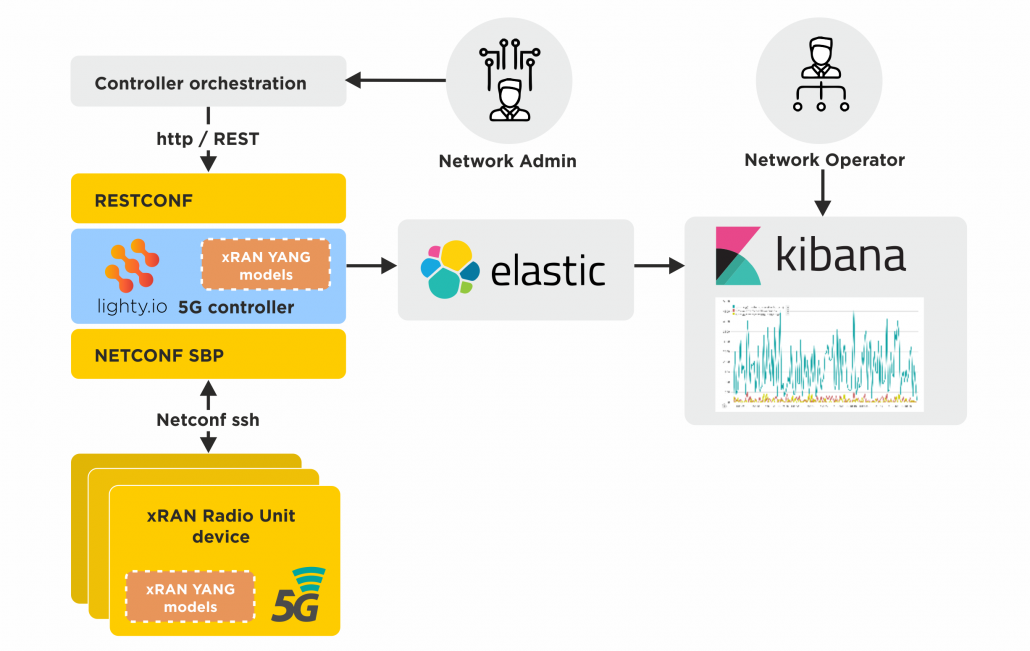In April 2018, the xRAN forum released the Open Fronthaul Interface Specification. The first specification made publicly available from xRAN since its launch in October 2016. The released specification has allowed a wide range of vendors to develop innovative, best-of-breed remote radio unit/head (RRU/RRH) for a wide range of deployment scenarios, which can be easily integrated with virtualized infrastructure & management systems using standardized data models.
This is where PANTHEON.tech came to the scene. We became one of the first companies to introduce full stack 5G compliant solution with this specification.
Just a few days spent coding and utilizing the readily available lighty.io components, we created a Radio Unit (RU) simulator and an SDN controller to manage a group of Radio Units.
Now, let us inspect the architecture and elaborate on some important details.
We have used lighty.io, specifically the generic NETCONF simulator, to set up an xRAN Radio Unit (RU) simulator. xRAN specifies YANG models for 5G Radio Units. lighty.io NETCONF device library is used as a base which made it easy to add custom behavior and 5G RU is ready to stream data to a 5G controller.
The code in the controller pushes the data collected from RUs into Elasticsearch for further analysis. RU device emits the notifications of simulated Antenna Line Devices connected to RU containing:
- Measured Rx and Tx input power in mW
- Tx Bias Current in mA (Internally measured)
- Transceiver supply voltage in mV (Internally measured)
- Optional laser temperature in degrees Celsius. (Internally measured)
*We used device xRAN-performance-management model for this purpose.
lighty.io as a 5G controller
With lighty.io we created an OpenDaylight based SDN controller that can connect to RU simulators using NETCONF. Once RU device is connected, telemetry data is pushed via NETCONF notifications to the controller, and then directly into Elasticsearch.
Usually, log stash is required to upload data into Elasticsearch. In this case, it is the 5G controller that is pushing device data directly to Elasticsearch using time series indexing.
On Radio Unit device connect event, monitoring process automatically starts. RPC-ald-communication is called on RU device collecting statistics for:
- The Number of frames with incorrect CRC (FCS) received from ALD – running counter
- The Number of frames without stop flag received from ALD – running counter
- The number of octets received from HDLC bus – running counter
*We used xran-ald.yang model for this purpose.
The lighty.io 5G controller is also listening to notifications from the RU device mentioned above.
Elasticsearch and Kibana
Data collected by the lighty.io 5G controller via RPC calls and notifications are pushed directly into Elasticsearch indices. Once indexed, Elasticsearch provides a wide variety of queries upon stored data.
Typically, we can display several faulty frames received from “Antenna Line Devices” over time, or analyze operational parameters of Radio Unit devices like receiving and transmitting input power.
Such data are precious for Radio Unit setup, so the control plane feedback loop is possible.
By adding Elasticsearch into the loop, data analytics or the feedback loop became ready to perform complex tasks. Such as: Faulty frame statistics from the “Antenna Line Devices” or the Radio Unit operational setup
How do we see the future of xRAN with lighty.io?
The benefit of this solution is a full stack xRAN test. YANG models and its specifications are obviously not enough considering the size of the project. With lighty.io 5G xRAN, we invite the Radio Unit device vendors and 5G network providers to cooperate and build upon this solution. Having the Radio Unit simulators available and ready allows for quick development cycle without being blocked by the RU vendor’s bugs.
lighty.io has been used as a 5G rapid application development platform which enables quick xRAN Radio Unit monitoring system setup.
We can easily obtain xRAN Radio Unit certification against ‘lighty.io 5G controller’ and provide RU simulations for the management plane.
Visit lighty.io page, and check out our GitHub for more details.




![[Release] OpenDaylight Titanium](https://pantheontech1.b-cdn.net/wp-content/uploads/2025/08/odl-titanium-release.png)
![[Meet Us] PANTHEON.tech @ Open Source Summit 2025 in Amsterdam](https://pantheontech1.b-cdn.net/wp-content/uploads/2025/08/OSS_Temp.png)
![[What Is] LAG & MLAG](https://pantheontech1.b-cdn.net/wp-content/uploads/2025/08/lag-mlag-thumb.png)